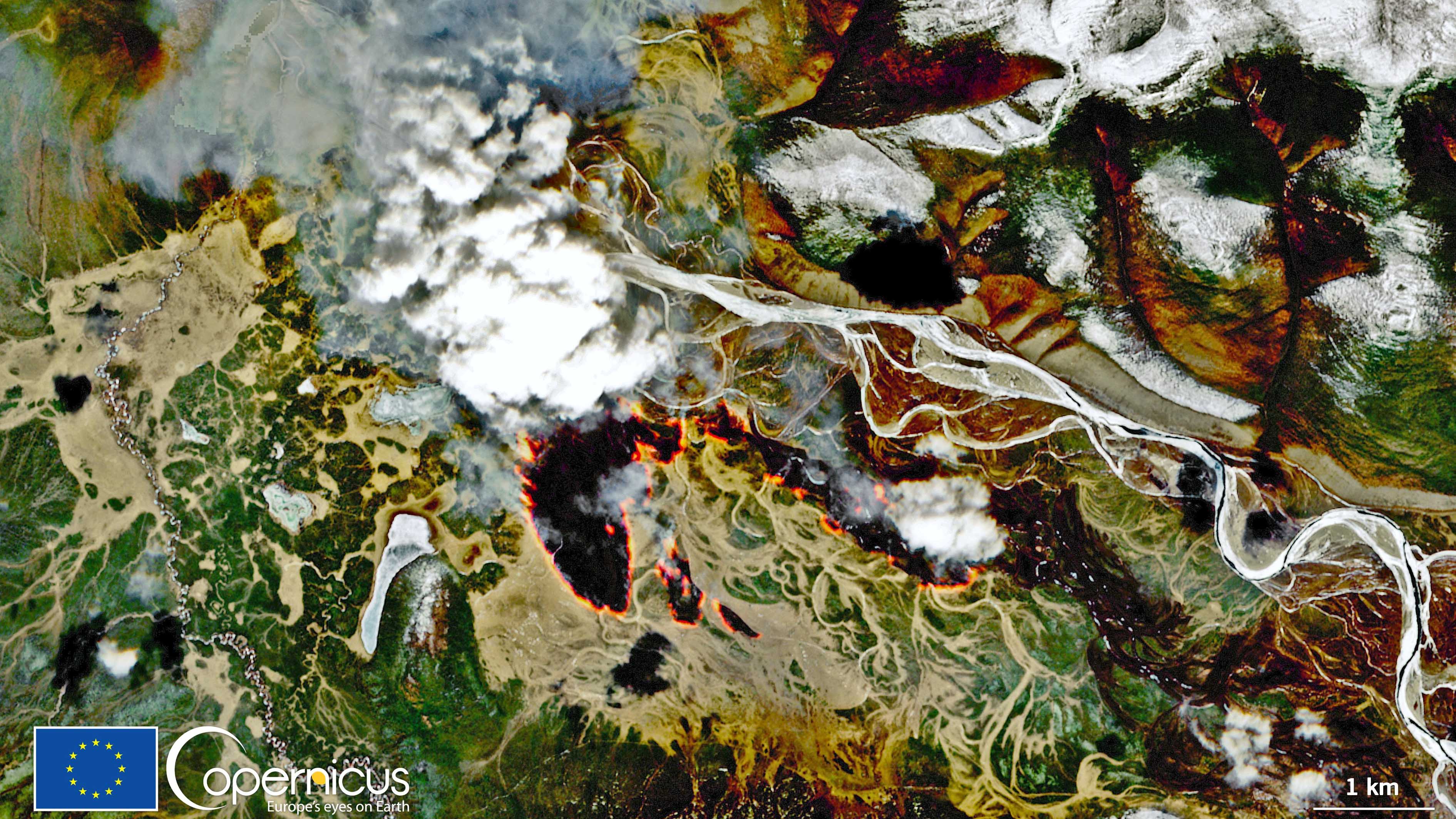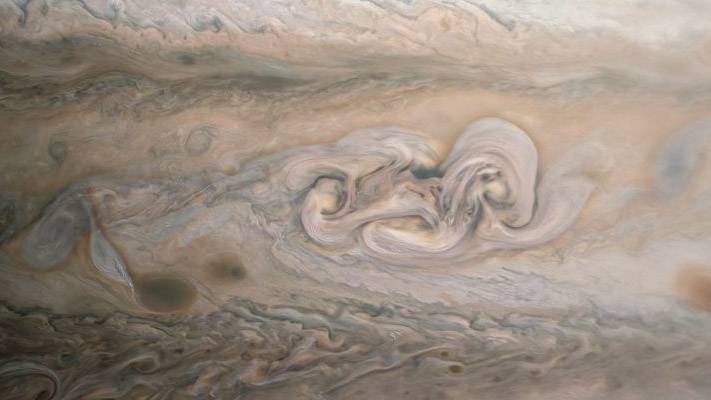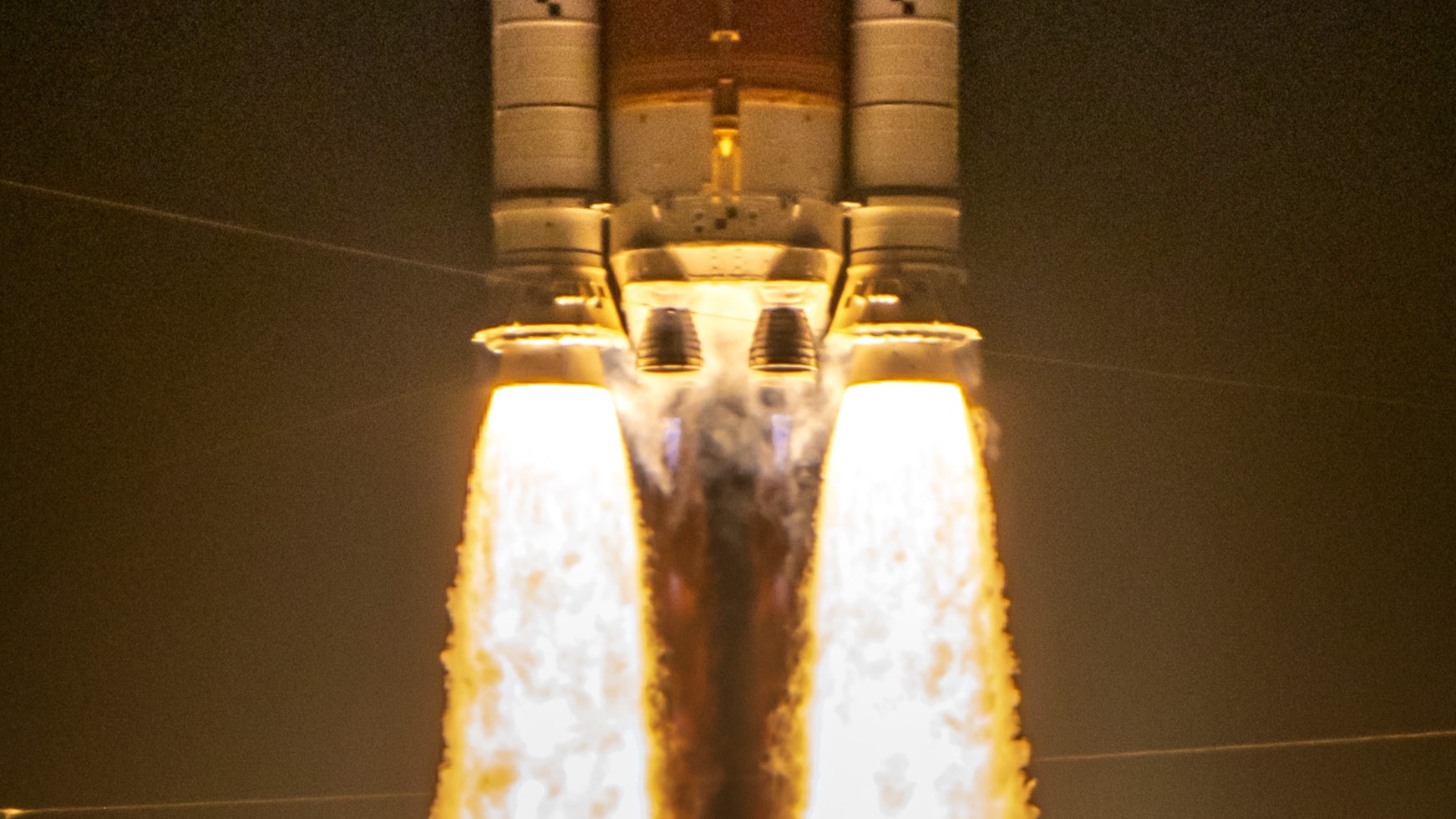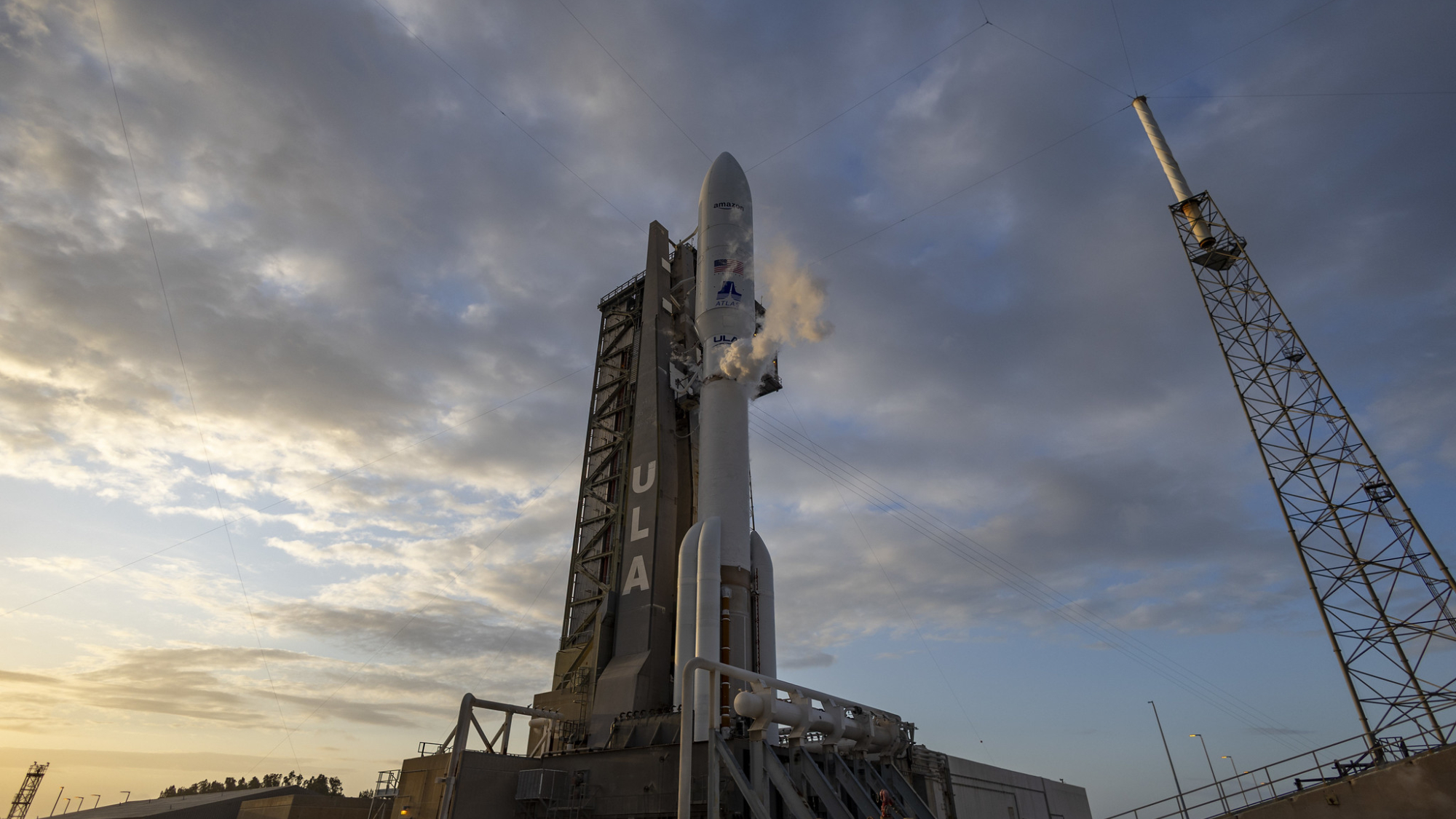May 2021
A SpaceX toasted marshmallow

Monday, May 3, 2021: SpaceX's Crew Dragon space capsule Resilience looks more like a toasted marshmallow than mythical fire-breathing beast in this image taken early Sunday, May 2, as a recovery team retrieves the spacecraft from the Gulf of Mexico off the coast of Panama City, Florida.
The Dragon spacecraft splashed down Sunday at 2:56 a.m. EDT (0656 GMT) to return four astronauts to Earth for NASA under SpaceX's Crew-1 mission. Returning home on Resilience were NASA astronauts Victor Glover, Mike Hopkins, Shannon Walker and Japan Aerospace Exploration Agency astronaut Soichi Noguchi. Their splashdown ended a six-month mission to the International Space Station. -- Tariq Malik
Hubble images Necklace Nebula

Tuesday, May 4, 2021: The Hubble Space Telescope team has released a new image of the so-called Necklace Nebula, an intriguing object consisting of a pair of stars orbiting only several million miles away from each other, so close that they appear as a single bright dot at the center of the image.
Located about 15,000 light-years away from Earth, the nebula, officially called PN G054.203.4, was first discovered in 2005 by the Isaac Newton Telescope Photometric H-alpha Survey (IPHAS). The object has been imaged by Hubble multiple times previously. The new image is an amalgamation of several exposures from Hubble’s Wide Field Camera 3 and was created with the help advanced processing techniques.
Roughly 10,000 years ago, one of the stars exploded, its gaseous envelope expanding into space, enveloping its companion star. The smaller star continues to orbit inside this envelope, further contributing the expansion of the nebula. The bright diamond-like shapes around the nebula’s ring are made of dense clumps of gas that formed inside the cloud of escaping debris. -- Tereza Pultarova
Harvest in 'Martian' greenhouse in Antarctica

Wednesday, May 5, 2021: NASA scientist Jess Bunchek harvests rocket at the EDEN ISS greenhouse in Antarctica. The greenhouse, operated by the German Aerospace Centre DLR, tests advanced technologies that might be used in the future to grow food on the Moon and Mars. Bunchek, who also works on NASA’s space agriculture projects including the Vegetable Production System Veggie that provides fresh greens to astronauts on the International Space Station, has grown a range of leafy greens, herbs and fruits at the EDEN ISS greenhouse including cucumbers, tomatoes, lettuce, basil and mint. The greenhouse uses the so-called aeroponics method that delivers nutrients and water directly to the plant roots, which are suspended in the air without the presence of soil. Bunchek is one of ten crew members overwintering at the Neumayer Station III, a research station operated by Germany’s Alfred Wegener Institute of Helmholtz Centre for Polar and Marine Research in Bremerhaven. Located about 2,000 kilometres (1,240 miles) away from the geographical South Pole on the Ekström Ice Shelf, the station faces harsh environmental conditions including temperatures of up to -50 degrees C (-58 degrees F) and wind speeds up to 80 mph (130 km/h). The crews are completely isolated over the 9-month Antarctic winter period. -- Tereza Pultarova
Stormy weather on Jupiter

Thursday, May 6, 2021: Giant storms whirl in the turbulent atmosphere on the southern hemisphere of Jupiter in this image captured by the visible-light JunoCam camera on board of NASA’s Juno spacecraft. The enhanced image showing the stormy weather on the largest planet of the solar system was captured during Juno’s 32nd close pass by the gas giant. Results from Juno’s nearly five years of exploration of Jupiter have been discussed recently at the European Geosciences Union conference in Vienna, Austria. Images from JunoCam are available to scientists and amateurs alike. -- Tereza Pultarova
Get the Space.com Newsletter
Breaking space news, the latest updates on rocket launches, skywatching events and more!
The Earth twin of ExoMars Rosalind Franklin heads for Mars yard

Friday, May 7, 2021: The ground test model of the European Rosalind Franklin ExoMars rover is about to leave the clean rooms of Thales Alenia Space in Turin, Italy, to commence a test campaign at the Mars Terrain Simulator of the nearby Rover Operations Control Center. Throughout the mission, ExoMars ground teams will be using the ground test model as Rosalind Franklin’s Earth twin to validate all operations in the simulator before sending any commands to Mars.
In this image, the structural-thermal model accompanies the ground test model as the two underwent testing together. The ExoMars rover, previously expected to launch in 2020, is now scheduled for lift-off between August and October 2022. Fitted with a 6.5 foot (2 meter) drill, the rover will search for signs of past and present life under the parched surface of Mars. -- Tereza Pultarova
Crew Dragon re-entry seen from space station

Monday, May 10, 2021: The Crew Dragon capsule Resilience leaves a fiery trail above Mexico as it hurtles through Earth's atmosphere, returning four astronauts, members of the Crew-1 mission, to Earth after more than five months in space. The picture was taken by the European Space Agency (ESA) astronaut Thomas Pesquet from aboard the International Space Station on May 2, shortly before the capsule splashed down in the Gulf of Mexico.
"Crazy to think that six hours after we closed the hatch on our friends, we saw them in that shooting star streaking through the night sky," Pesquet wrote on Twitter where he posted the image. "This is a sight I’ll remember all my life."
Pesquet arrived at the orbital outpost on board of SpaceX Crew Dragon Endeavour on April 24. Together with his Crew-2 colleagues, NASA astronauts Shane Kimbrough and Megan McArthur, and Japan's Akihiko Hoshide, he will stay at the station until late October this year. Crew-2 shares the space station with members of the Soyuz MS-18 mission, Russian cosmonauts Oleg Novitsky and Pyotr Dubrov, and NASA astronaut Mark Vande Hei, who arrived on April 9. -- Tereza Pultarova
Crowds watch launch of China’s space station

Tuesday, May 11, 2021: An excited crowd watches the lift-off of China’s Long March 5B rocket carrying the core module of the Tianhe space station. Tianhe, meaning Harmony of the Heavens, will be about 20% of the mass of the International Space Station once completed. The core module was launched on April 28 from the Wenchang Spacecraft Launch Site on the island of Hainan in southern China. The rocket’s 23-ton core stage caused serious concerns as it crashed uncontrollably to Earth more than ten days after the launch.
China plans to launch two additional modules to create the final T-shaped station by 2022. First astronauts may, however, visit the new orbital outpost already in June this year. -- Tereza Pultarova
Siberia ablaze as zombie fires reawaken

Wednesday, May 12, 2021: The European Sentinel 2 satellite captured a fire cloud generated by a blazing wildfire near the town of Oymyakon in north-eastern Siberia, close to the Arctic circle, on May 2.
Siberia has been plagued with wildfires for several years. Since the beginning of 2021, more than 400 forest fires have been reported with the regions of Tyumen, Omsk and Novosibirsk especially badly affected, according to the Russian Federal Forestry Agency. Many of the current fires probably started in 2020 and survived the winter smouldering in the peats. Those “zombie fires” have reawaken in the approaching spring despite freezing temperatures as low as minus 60 degrees Fahrenheit (minus 50 degrees Celsius).
Wildfires are part of the vicious cycle of climate change. The frequency and scale of wildfires increases due to the rising temperatures and frequent draughts. At the same time, the blazes emit large amounts of carbon dioxide, which further contributes to global warming.
According to the EU Copernicus Atmosphere Monitoring Service (CAMS), the amount of carbon dioxide emitted by Arctic wildfires just during the summer of 2020 was 35% higher, at 244 megatonnes, than the emission-record set previously by the entire 2019. -- Tereza Pultarova
OSIRIS-REx final shot of Benu

Friday, May 14, 2021: The waning crescent of Asteroid Bennu can be seen in the last image captured by the NASA OSIRIS-REx spacecraft before its departure from the space rock. NASA released the image on May 11, but it was taken already on April 9, about a month before OSIRIS-REx embarked on its journey home on May 10. The space probe, NASA's first to collect a sample from an asteroid, will return to Earth in September 2023. It carries 2 ounces (60 grams) of regolith it collected during a brief touch down in October 2020.
Asteroids are like time capsules, providing scientists with a window into the earliest period of the solar system formation. Lacking atmospheric and geological processes, they are made of rocks that have not changed over billions of years. Bennu, however, presented some surprises to the researchers as it turned out to be much rockier than predicted from ground-based observations.-- Tereza Pultarova
Heatwave crushes the Arctic

Monday, May 17, 2021: Land surface temperatures of more than 85 degrees Fahrenheit (30 degrees Celsius) have been recorded close to the Arctic Circle last week as shown in this image captured by the European Earth-monitoring satellite Sentinel-3 on Thursday (May 13).
Maximum daytime air temperatures soared to 80 degrees F (27 degrees C) in parts of Northwestern Russia around the White Sea, a deviation of 23 to 36 degrees F (13 to 20 degrees C) from the average typical for this period of the year.
Last year, the Arctic region experienced months of unusually hot weather. The 2020 heatwave led to destructive wildfires and the second lowest summer sea ice extent on record. Hot summer spells are not unusual in the Arctic. However, according to available data, the region is warming two to three times faster than the global average. -- Tereza Pultarova
Hubble spots faint emission nebula

Tuesday, May 18, 2021: The bright fluffy cloud in this image captured by the Hubble Space Telescope is the so-called emission nebula NGC 2313. Part of the constellation Monoceros (Greek for Unicorn), the nebula is formed of ionized light-emitting gas centered around the star V565. Some 3,700 light years away from the sun, the nebula, first discovered in 1862, can be found close to the much brighter Orion constellation but is not visible to the naked eye. -- Tereza Pultarova
Sun sets above Jezero Crater

Wednesday, May 19, 2021: The Left Navigation Camera (Navcam) of the NASA Perseverance rover captured this image of a late afternoon sun above Jezero Crater at 15:38 pm on May 17, the rover's 85th sol on Mars. Sol, a Martian day, is about 40 minutes longer than a day on Earth, which means the planets' times constantly diverge. The two Navcams, located on top of the rover's mast, help Perseverance drive autonomously and safely avoid obstacles. When not capturing atmospheric sceneries, the Navcams can detect objects as small as a golf ball up to 82 feet (25 meters) away. -- Tereza Pultarova
Juno spots new feature in Jupiter’s atmosphere

Thursday, May 20, 2021: NASA’s Juno mission captured images of Clyde’s Spot, a new feature in the atmosphere of Jupiter, first observed last year by an amateur astronomer in South Africa. Named after its discoverer, retired engineer and avid sky-watcher Clyde Foster, the plume of cloud erupting above the gas giant’s atmosphere southeast of the famous Great Red Spot, has undergone substantial changes since its discovery in May last year.
Juno flew over the area during its 33rd close pass on April 15 at a distance of about 16,800 miles (27,000 kilometers) from the top cloud layer. The images, captured by the JunoCam camera, reveal that the remnants of Clyde’s Spot had drifted away from the Great Red Spot and developed into a complex structure that scientists call a folded filamentary region. Twice as wide and three times as long as the original spot, the evolved feature might persist for an extended period of time, the scientists believe. Juno originally observed the spot in June 2020, only two weeks after Foster’s discovery. -- Tereza Pultarova
Egypt's Great Pyramid seen by new very-high resolution satellite

Friday, May 21, 2021: The Great Pyramid of Giza, also known as the Pyramid of Cheops, was captured by the new Pléiades Neo 3 satellite of European aerospace company Airbus. Launched in late April this year, Pléiades Neo 3 sees details as small as 30 cm (1 foot). The image of the 481-foot-high (147.6 m) pyramid was part of the first release of test images taken by the satellite earlier this month. Single limestone blocks that the pyramid is made of can be distinguished in the image as well as individual visitors to the world-famous archeological site on the outskirts of the Egyptian capital Cairo. -- Tereza Pultarova
Wildfires erupt in Canada as early heatwave arrives

Monday, May 24, 2021: Plumes of smoke rising from wildfires that erupted in the Canadian province of Manitoba after the arrival of an early heatwave have been captured by NASA's Earth-observation satellite Aqua last week.
While the second week of May still saw ice covering most of Lake Winnipeg, by May 19 temperatures in the region soared to 86 to 91 degrees Fahrenheit (30° and 33° Celsius). Southern Manitoba as well as the neighboring Saskatchewan have been suffering from lack of rain since last fall, which has resulted in extreme drought that makes the area vulnerable to wildfire outbreaks.
In the image, captured May 18, thick billows of smoke spread to the northwest towards Hudson Bay and into the Canadian interior. Fires have been reported in other locations as well. The indigenous Misipawistik Cree and Lake St. Martin First Nations communities were encouraged to evacuate. -- Tereza Pultarova
Moon spaceship splashes in a pool

Tuesday, May 25, 2021: NASA's Orion space capsule, a key piece of technology that will enable humanity's return to the moon in 2023, has completed its fourth and final water impact test at the NASA Langley Research Center in Hampton, Virginia.
During the test, a structural replica of the spacecraft was swung from the height of 80 feet (24 meters) and the distance of 135 feet (41 meters) into an impact pool, hitting the water surface at 41 miles per hour (65 kilometers per hour).
The data generated during the experiment will help engineers finetune the structural design of the capsule ahead of its uncrewed launch in November this year. The spacecraft will now be sent back to the facilities of aerospace company Lockheed Martin, the prime contractor responsible for the development and assembly of the capsule for NASA. -- Tereza Pultarova
Lighting up the Super Flower Blood Moon

Wednesday, May 26, 2021: A man looks towards the supermoon full moon and the Milky Way on May 26, 2021 in Rylstone, Australia in this image by photographer Mark Evans for Getty Images.
The observer's flashlight appears to reach toward the moon in this image. It occurred during a total lunar eclipse, the only one of 2021, in an event billed as the Super Flower Blood Moon.
You can see video of the lunar eclipse here, as well as images and early reactions from stargazers. For more photos, check out our gallery below.
Super Flower Blood Moon: Amazing photos of the total lunar eclipse of 2021
-- Tariq Malik
Astronauts test reaction times with the help of virtual reality

Thursday, May 27, 2021: Japanese astronaut Akihiko Hoshide floating inside the International Space Station with a virtual reality headset as part of a European Space Agency (ESA) experiment designed to measure how the microgravity environment affects reaction times.
Hoshide's colleague, ESA astronaut Thomas Pesquet, who oversaw the experiment, tweeted the image on Wednesday, May 26.
According to ESA, astronauts' perceptions of distances are skewed in microgravity and since perceptions of time and space are believed to be governed by the same neural processes, scientists want to know whether the perception of time is also affected. In the past, astronauts reacted to prompts on a laptop screen, but Pesquet explained in the recent tweet that the VR headset blocks out other visual impulses more effectively, which results in more precise data.--Tereza Pultarova
Astronauts snap lunar eclipse from International Space Station

Friday, May 28, 2021: Astronauts aboard the International Space Station captured the super flower blood moon lunar eclipse on Wednesday, May 26, as they hurtled around the planet at 17,900 mph (8 kps). The space station, orbiting at the altitude of 260 miles (400 km), completes one round around Earth in about 90 minutes, which means the astronauts must have gotten a shorter glimpse of the celestial spectacle than stargazers on Earth. The advantage of the space-based vantage point, however, was the perfectly cloudless sky.
Wednesday’s eclipse, the only total lunar eclipse of 2021, was best observable from the Pacific region including Australia, New Zealand, Hawaii and Papua New Guinea, but skywatchers in the western part of the Americas and eastern Asia got to enjoy at least some parts of it, even though many observers were left disappointed by cloudy weather at their location. -- Tereza Pultarova
Can't find the date you're looking for? It may have been a weekend or holiday, when we don't normally update our Image of the Day.
Click 'NEXT PAGE' below for June >
Check out our Image of the Day Archives for more awesome photos.
Image of the Day 2023 Archive

Image of the Day 2022 Archive

Image of the Day 2021 Archive

Image of the Day 2020 Archive

Image of the Day 2019 Archive

Join our Space Forums to keep talking space on the latest missions, night sky and more! And if you have a news tip, correction or comment, let us know at: community@space.com.

Space.com is the premier source of space exploration, innovation and astronomy news, chronicling (and celebrating) humanity's ongoing expansion across the final frontier. Originally founded in 1999, Space.com is, and always has been, the passion of writers and editors who are space fans and also trained journalists. Our current news team consists of Editor-in-Chief Tariq Malik; Editor Hanneke Weitering, Senior Space Writer Mike Wall; Senior Writer Meghan Bartels; Senior Writer Chelsea Gohd, Senior Writer Tereza Pultarova and Staff Writer Alexander Cox, focusing on e-commerce. Senior Producer Steve Spaleta oversees our space videos, with Diana Whitcroft as our Social Media Editor.









